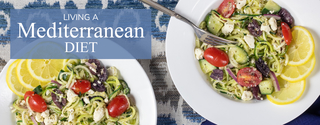
The Mediterranean diet has certainly gotten a lot of buzz in recent years and it has long had a reputation as a healthy lifestyle. Even many of us who may not be regular practitioners of this type of diet probably know that it is built on consuming lots of fruits, vegetables, nuts, olive oil, fish and little to no red meat. Mediterranean cuisine looks like it will continue to gain in popularity because of its healthy cooking techniques, ingredients and use of light sauces.
To fully appreciate the nuances of the Mediterranean diet you have to understand what countries make up the Mediterranean region. The foods from this area come from a much wider area than just Greece, Spain and Italy. The unique flavors of this region draw from the northern Africa, southern Europe and the Middle Eastern countries that border this area. Like many other regional cuisines, there are some common ingredients that are frequently used across the entire region and then some ingredients are more specific to various local areas. Some of the more widely used ingredients include beans, dried fruits, garlic, lamb, olive oil, parsley and pimentos.
Leafy spices such as basil, oregano, rosemary and thyme along with tomatoes and wine are staples in northern Mediterranean (Italy, southern France and northern Spain) dishes. In the western Mediterranean area of Spain, bacalao (dried salt cod), saffron and sofrito are quite popular. The eastern Mediterranean area is made of up primarily of Cyprus, Israel, Lebanon, Syria and Turkey. Their unique flavors include pomegranate juice, mint, sesame and yogurt. The northern Africa region (Egypt, Libya, Ethiopia, Malta, Tunisia, Algeria and Morocco) has a reputation for spicier flavors such as cayenne, coriander, harissa and long pepper.
Similar to the Asian regional cuisine, the Mediterranean cuisine is also heavily influenced by the various religions found throughout. While the Italians and French enjoy wine with their meals and in their cooking, this is not something found in the Muslim countries. You will also not find the Jews or the Muslims using pork in any of their recipes while pork and veal are favored meats in France, Italy and Spain.
Popular Ingredients in Mediterranean Cuisine
A variety of breads, fruits, olive oil and vegetables are used in the Mediterranean diet but flavor variety comes from the use of dried fruits, pickled vegetables, olives and spiced fish and meats. Seafood is a staple meat and is used dried, fresh, grilled, pureed or as a stock.
Cheese - Popular cheeses used in the northern and western Mediterranean include ricotta, feta, mozzarella, gruyere and romano. These are used in everything from toppings for main dishes, to salads, vegetables and even desserts. In the North African and Middle Eastern region the use of yogurt is used plain, mixed with fruit or as a sauce.
Grains - Coucous is popular throughout North Africa and is used in one pot meals or as side dishes. The various Mediterranean regions have rice preferences including fluffy, firm, sticky or soft. Rice may be served plain or in one pot meals such as paella.
Breads - Flat breads are used to scoop up food, soak up sauces or for dipping into oil. A variety of beans, peas and lentils are also widely used and some of these include chickpeas, split peas, black eyed peas, kidney beans, navy beans and white fava beans and red lentils. These are used to provide texture and body to various noodles, rice, salads and stews.
Olives -Olives are very common throughout the region and come in a wide variety of sizes, shapes and colors. In addition to being made into oil they can be served stuffed, pickled, as an appetizer or as a sauce.
Nuts - Nuts are popular because they pair so well with butter, chiles, raisins, spices and tomatoes. Some of the more popular nuts used are almonds, pine nuts and walnuts.
Fruits - Fresh fruits are added to desserts, preserved in syrups or eaten fresh. Some of the Mediterranean diet's most popular fresh fruits include apples, figs, melons, nectarines, oranges, peaches, pears, pomegranates and strawberries. Dried fruits are popular with duck, fish and pork and are often combined with nuts and spices. Some of the more common dried fruits are apricots, dates, figs, prunes and raisins.
Vegetables - There are a wide variety of vegetables used in Mediterranean cuisine and these include artichoke, asparagus, cabbage, cardoon, eggplant, fennel, leeks, mushrooms, pumpkin, potatoes, radicchio and zucchini. These may be eaten raw or baked, grilled, fried, pickled, sautéed or steamed.
Cooking Styles
The various cooking styles found in the Mediterranean region are as diverse as the wide selection of ingredients used. The healthy tasty dishes of this area are created using various braising, grilling, marinating and pickling techniques. Grilling fish, meat and vegetables is the most popular method in the northern Mediterranean using various woods to provide different flavors.
So, armed with all of this you are well on your way to understanding more about the subtle nuances of the Mediterranean diet and what you might want to try and incorporate into your healthier eating habits. And maybe best of all the next time one of your friends or family starts talking about the benefits of the Mediterranean diet you'll be able to add plenty to the conversation.

